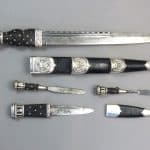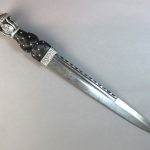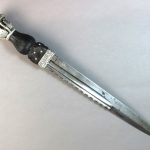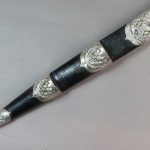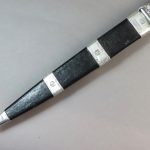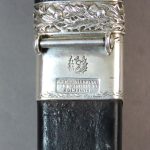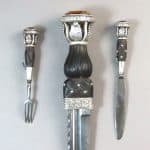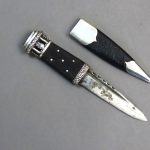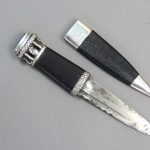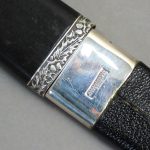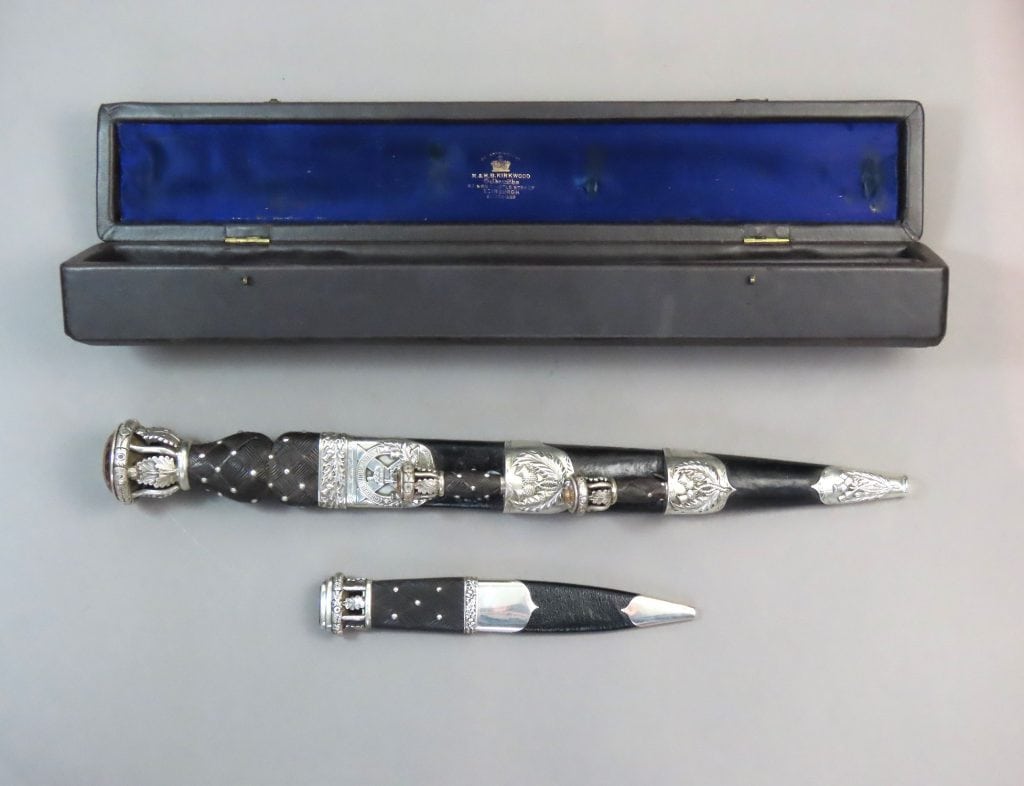
A Late 19th century Scottish Dirk for an Officer in the Gordon Highlanders by R&HB Kirkwood of Edinburgh
To enquire about this itemplease click here
Price: £5,650
Ref: 42122106
Item Description
An exceptional Scottish Military Dirk made for an officer in the Gordon Highlanders in the late 19th century by the goldsmiths R&HB Kirkwood based at 65 & 66 Thistle Street in Edinburgh. The dirk retains its bi-knife and fork which together are housed in the original case with the partner sgian dubh. The mounts are of unhallmarked silver.
The grips of the dirk, bi-knife, fork and sgian dubh are fashioned from blackened hardwood carved with a pattern of basketweave with studs mounted at the intersections of the weave. The raised ornate pommels are each mounted with a finely cut Citrine with consistent orange coloured backing inside decorative ferrules featuring bands of thistles and foliage. The pommels are suspended above the grips in typical dirk style for the Gordon Highlanders with an arrangement of silver posts separated by oak leaves.
The dirk grip base mount is decorated with thistles and foliage. The cone shaped grip bases of the bi-knife and fork are plain and mounted with blued sprung clips on either side to secure the grips to the scabbard pocket tops.
The leaf shaped dirk blade is 11.75 inches (30 cm) long and has a scalloped back edge under which a deep fuller extends from the grip base towards the tip and terminates just before the scallop line ends, after which the blade becomes double edged to the tip. A wider fuller extends from the hilt along the middle of the blade for the same length.
The base to the dirk grip fits snugly over the scabbard mouthpiece. The bi-knife blade is also single-edged and has a scalloped blunt back edge of smaller dimensions compared to the dirk blade.
The dirk is housed in a wooden scabbard covered with black leather and with silver mounts. The throat mount to the front is decorated with a Cross of St Andrew onto which at the base is a platform of thistles. A semi-circular arch above is applied with the name of the regiment and beneath this a figure of the Sphynx with “EGYPT” beneath, and below, a Tiger with “INDIA” beneath.
The back of the throat mount has a carrying strap bar with the name of the maker in raised relief inside a rectangular shield beneath. Further along the scabbard the pocket throat mounts for the by-knife and by-fork, plus the chape, are decorated to the front with a thistle motif and at the back each mount is stamped individually with a thistle stamp. The overall length is 17.25 inches (just under 44 cm) overall.
The double-hinged black leather covered wooden storage box is in fine condition. The lid opens and closes effectively to be secured with hinged clips. The box is fitted with a padded blue silken liner fixed into the into the base of the compartment and into the lid which also has the embossed name of the maker. The sgian dubh is similarly stamped with the maker’s details at the back of the throat mount.
The Gordon Highlanders was one of the most famous regiments in the British Army. It was formed in 1881 as the county regiment of Aberdeen, Banffshire and Shetland. In the 1880s the regiment fought in the Anglo-Egyptian War then in India in the 1890s. In 1899 the regiment was sent to fight in the Boer War. Thereafter the regiment fought with distinction in all major conflicts where the British Army was involved.
The dirk was first presented to the open market by the descendants of the officer that owned the dirk. This was Stewart Gregor Murray. His military biography is detailed on a old note written in black ink stored inside the case (see the last photo below). He joined the Second Battalion in 1884 and thereafter was posted to Malta (3 years), Ceylon (3 years) and India (4 years). In India Murray was involved in the storming of the Malakand Pass and in the Relief of Chitral. He returned to the UK in 1895 and was appointed to the role of Adjutant for the 2nd Volunteer Battalion. He was promoted to Captain in 1895 then Major in 1903. Murray resigned his commission in 1904 after 20 years service.
Condition:
The condition of the dirk is very fine with minor wear as can in be seen in the photos. The pommel stones are in excellent original condition with no cracks, chips or interference to the mount housings. One stud is missing from the front of the main dirk haunch base and two from the upper part of the grip of the fork. The sgian dubh is in fine condition with some mottling to the blade. The storage box is in a fine state of preservation. The steel dirk blade retains its polished finished with minor light stains in a few places.



